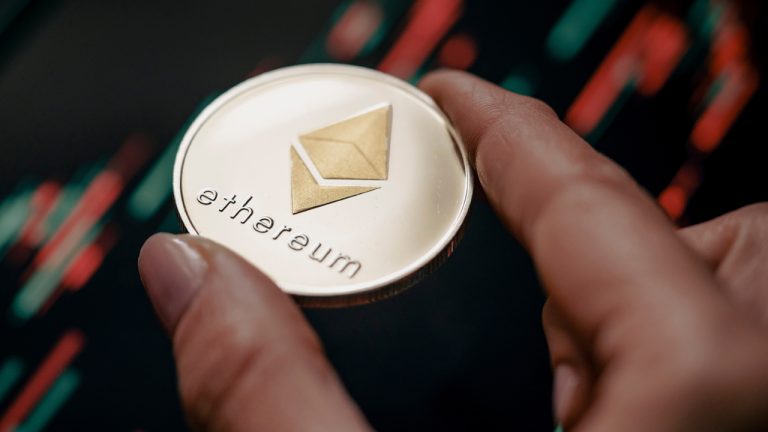
In the ever-volatile world of cryptocurrency assets, ethereum has experienced a significant decline, with its price dropping by 8.1% in the past 24 hours. The prevailing bearish sentiment, as indicated by technical indicators and chart patterns, is urging traders to exercise caution in their trading activities.
Ethereum's Price Movement
The price of ethereum (ETH) currently fluctuates between $2,056 and $2,255, following a tumultuous 24-hour trading session that saw it range from $2,148 to $2,392 per unit. With a market capitalization of $265 billion and a trading volume of $30.91 billion, ethereum's market is highly active and filled with high stakes. These figures set the stage for a more detailed analysis of the technical factors impacting ethereum's price action.
Oscillators serve as indicators of momentum and potential reversals in price trends. Currently, the relative strength index (RSI) stands at 46.4, while the Stochastic indicator is at 56.6. Both suggest a neutral to bearish market sentiment. Similarly, the commodity channel index (CCI) and the average directional index also support this neutral outlook. However, like bitcoin's charts, the momentum and moving average convergence/divergence (MACD) levels lean toward a negative sentiment, indicating potential bearish undertones amid the prevailing market uncertainty.
The behavior of moving averages (MAs) provides insights into the overall market trends across different time frames. In the short term, both the exponential moving averages (EMAs) and the simple moving averages (SMAs 10, 20, and 30) predominantly suggest a negative market sentiment, reflecting the current bearish outlook. On the other hand, the longer-term averages (50, 100, and 200) lean towards a positive perspective, indicating the possibility of a bullish recovery in the long run. This dichotomy emphasizes the volatility of the market and the differing viewpoints based on the time horizon.
On the 1-hour ETH/USD chart, a significant downward trend is observed, indicating a substantial sell-off. Traders are advised to wait for signs of market consolidation or bullish reversal patterns before entering any positions to avoid the intense downward momentum. For those looking to exit their positions, it is crucial to limit losses as the significant declines breach prior support levels, signaling a sharp downturn.
Similarly, the 4-hour ETH/USD graph reveals a distinct bearish trend characterized by extended and notable falls. The focus here should be on achieving market stability and identifying bullish reversals within a 12 to 24-hour period before making any entry decisions. Exit strategies should take advantage of oversold conditions following the swift downturn, with a close watch on support thresholds and market pullbacks.
The daily ETH/USD chart provides a broader perspective, illustrating alternating bullish and bearish days that culminated in the significant decline witnessed on the previous day. This pattern indicates heightened market volatility with a strong inclination towards bearishness. Entry strategies should be carefully executed, looking for definitive bullish reversal indications over an extended period. Across all three time frames, the prevalent bearish sentiment underscores the importance of rigorous risk management and strategic foresight in these fluctuating market conditions.
Bullish Outlook:
Despite the prevailing bearish trends in the short term, ethereum's market performance demonstrates resilience through favorable longer-term moving averages and the neutral stance of key oscillators. If traders can identify strong bullish reversal patterns and the market reacts positively to external stimuli or news, there is a possibility of a substantial recovery on the horizon.
Bearish Outlook:
Current technical indicators and chart patterns heavily favor a continued bearish outlook for ethereum. The dominance of negative signals in both short-term moving averages and oscillators, combined with significant downward trends across various time frames, suggest that the market may not have reached its bottom yet.
Register your email here to receive weekly price analysis updates sent directly to your inbox:
What are your thoughts on ethereum's market action on Wednesday morning? Share your opinions and insights in the comments section below.
Frequently Asked Questions
Is it a good retirement strategy to buy gold?
Although gold investment may not seem appealing at first glance due to the high average global gold consumption, it's worth considering.
The most popular form of investing in gold is through physical bullion bars. But there are many other options for investing in gold. You should research all options thoroughly before making a decision on which option you prefer.
If you don’t have the funds to invest in safe places, such as a safe deposit box or mining equipment companies, buying shares of these companies might be a better investment. If you need cash flow to finance your investment, then gold stocks could be a good option.
You also can put your money into exchange-traded funds (ETFs), which essentially give you exposure to the price of gold by holding gold-related securities instead of actual gold. These ETFs typically include stocks from gold miners, precious metallics refiners, commodity trading companies, and other commodities.
Is it possible to hold a gold ETF within a Roth IRA
You may not have this option with a 401(k), however, you might want to consider other options, like an Individual retirement account (IRA).
An IRA traditional allows both employees and employers to contribute. Another option is to invest in publicly traded corporations with an Employee Stockownership Plan (ESOP).
An ESOP provides tax advantages because employees share ownership of company stock and profits the business generates. The money invested in the ESOP is then taxed at lower rates than if it were held directly in the hands of the employee.
An Individual Retirement Annuity (IRA) is also available. With an IRA, you make regular payments to yourself throughout your lifetime and receive income during retirement. Contributions to IRAs don't have to be taxable
What does a gold IRA look like?
The Gold Ira Accounts are tax-free investment options for those who want to make investments in precious metals.
Physical gold bullion coin can be purchased at any time. You don't have to wait until retirement to start investing in gold.
An IRA allows you to keep your gold forever. When you die, your gold assets won't be subjected to taxes.
Your heirs will inherit your gold, and not pay capital gains taxes. You don't need to include your gold in your final estate report, as it isn't part of the estate.
To open a gold IRA, you will first need to create an individual retirement account (IRA). Once you've done that, you'll receive an IRA custody. This company acts like a middleman between the IRS and you.
Your gold IRA custodian can handle all paperwork and submit necessary forms to IRS. This includes filing annual reporting.
After you have established your gold IRA you will be able purchase gold bullion coin. Minimum deposit is $1,000 If you make more, however, you will get a higher interest rate.
You'll have to pay taxes if you take your gold out of your IRA. You'll have to pay income taxes and a 10% penalty if you withdraw the entire amount.
You may not be required to pay taxes if you take out only a small amount. However, there are exceptions. There are some exceptions. For instance, if you take out 30% or more from your total IRA assets, federal income taxes will apply plus a 20 percent penalty.
You should avoid taking out more than 50% of your total IRA assets yearly. You could end up with severe financial consequences.
What proportion of your portfolio should you have in precious metals
To answer this question, we must first understand what precious metals are. Precious Metals are elements that have a very high relative value to other commodities. They are therefore very attractive for investment and trading. Gold is today the most popular precious metal.
However, many other types of precious metals exist, including silver and platinum. The price of gold tends to fluctuate but generally stays at a reasonably stable level during periods of economic turmoil. It is also not affected by inflation and depression.
In general, all precious metals have a tendency to go up with the market. However, they may not always move in synchrony with each other. For example, when the economy is doing poorly, the price of gold typically rises while the prices of other precious metals tend to fall. Investors expect lower interest rate, making bonds less appealing investments.
However, when an economy is strong, the reverse effect occurs. Investors want safe assets such Treasury Bonds and are less inclined to demand precious metals. Since these are scarce, they become more expensive and decrease in value.
Diversifying across precious metals is a great way to maximize your investment returns. Furthermore, because the price of precious Metals fluctuates, it is best not to focus on just one type of precious Metals.
How do I open a Precious Metal IRA
The first step is to decide if you want an Individual Retirement Account (IRA). To open the account, complete Form 8606. You will then need to complete Form 5204 in order to determine which type IRA you are eligible. This form must be submitted within 60 days of the account opening. You can then start investing once you have this completed. You might also be able to contribute directly from the paycheck through payroll deduction.
For a Roth IRA you will need to complete Form 8903. Otherwise, it will be the same process as an ordinary IRA.
To qualify for a precious-metals IRA, you'll need to meet some requirements. The IRS states that you must be at least 18 and have earned income. You can't earn more than $110,000 per annum ($220,000 in married filing jointly) for any given tax year. Contributions must be made on a regular basis. These rules will apply regardless of whether your contributions are made through an employer or directly out of your paychecks.
You can invest in precious metals IRAs to buy gold, palladium and platinum. However, you can't purchase physical bullion. This means you won't be allowed to trade shares of stock or bonds.
Your precious metals IRA can be used to directly invest in precious metals-related companies. Some IRA providers offer this option.
However, investing in precious metals via an IRA has two serious drawbacks. First, they don't have the same liquidity as stocks or bonds. This makes them harder to sell when needed. They don't yield dividends like bonds and stocks. So, you'll lose money over time rather than gain it.
What is the best precious metal to invest in?
This question depends on how risky you are willing to take, and what return you want. Although gold has traditionally been considered a safe investment choice, it may not be the most profitable. You might not want to invest in gold if you're looking for quick returns. You should invest in silver if you have the patience and time.
If you're not looking to make quick money, gold is probably your best choice. Silver might be a better investment option if steady returns are desired over a long period of time.
What amount should I invest in my Roth IRA?
Roth IRAs let you save tax on retirement by allowing you to deposit your own money. These accounts cannot be withdrawn until you turn 59 1/2. However, if you do decide to take out some of your contributions before then, there are specific rules you must follow. You cannot touch your principal (the amount you originally deposited). No matter how much money you contribute, you cannot take out more than was originally deposited to the account. You must pay taxes on the difference if you want to take out more than what you initially contributed.
The second rule is that your earnings cannot be withheld without income tax. When you withdraw, you will have to pay income tax. For example, let's say that you contribute $5,000 to your Roth IRA every year. Let's also say that you earn $10,000 per annum after contributing. The federal income tax on your earnings would amount to $3,500. The remaining $6,500 is yours. You can only take out what you originally contributed.
So, if you were to take out $4,000 of your earnings, you'd still owe taxes on the remaining $1,500. You would also lose half of your earnings because they are subject to another 50% tax (half off 40%). So even though your Roth IRA ended up having $7,000, you only got $4,000.
Two types of Roth IRAs are available: Roth and traditional. Traditional IRAs allow you to deduct pretax contributions from your taxable income. To withdraw your retirement contribution balance plus interest, your traditional IRA is available to you. There are no restrictions on the amount you can withdraw from a Traditional IRA.
A Roth IRA doesn't allow you to deduct your contributions. But once you've retired, you can withdraw the entire contribution amount plus any accrued interest. Unlike a traditional IRA, there is no minimum withdrawal requirement. You don't have to wait until you turn 70 1/2 years old before withdrawing your contribution.
Statistics
- Indeed, several financial advisers interviewed for this article suggest you invest 5 to 15 percent of your portfolio in gold, just in case. (aarp.org)
- If you accidentally make an improper transaction, the IRS will disallow it and count it as a withdrawal, so you would owe income tax on the item's value and, if you are younger than 59 ½, an additional 10% early withdrawal penalty. (forbes.com)
- If you take distributions before hitting 59.5, you'll owe a 10% penalty on the amount withdrawn. (lendedu.com)
- Contribution limits$6,000 (49 and under) $7,000 (50 and up)$6,000 (49 and under) $7,000 (50 and up)$58,000 or 25% of your annual compensation (whichever is smaller) (lendedu.com)
- Instead, the economy improved, stocks rebounded, and gold plunged, losing 28 percent of its value in 2013. (aarp.org)
External Links
investopedia.com
cftc.gov
wsj.com
- Saddam Hussein's InvasionHelped Uncage a Bear In 1991 – WSJ
- Are you interested in keeping gold in your IRA at-home? It's Not Exactly Legal – WSJ
forbes.com
How To
Guidelines for Gold Roth IRA
The best way to invest for retirement is by starting early. It is best to start saving for retirement as soon you can (typically at age 50). It's vital to contribute enough money each year to ensure adequate growth on an ongoing basis.
Additionally, tax-free opportunities like a traditional 401k or SEP IRA are available. These savings vehicles permit you to make contributions, but not pay any tax until your earnings are withdrawn. This makes them a great choice for people who don’t have access employer matching funds.
The key is to save regularly and consistently over time. If you aren't contributing the maximum amount permitted, you could miss out on tax benefits.
—————————————————————————————————————————————————————————————–
By: Jamie Redman
Title: Ethereum Technical Analysis: ETH Slides Over 8% Amid Downward Market Pressure
Sourced From: news.bitcoin.com/ethereum-technical-analysis-eth-slides-over-8-amid-downward-market-pressure/
Published Date: Wed, 03 Jan 2024 15:30:18 +0000
Related posts:
 Ethereum Technical Analysis: ETH Faces Downward Pressure; Bearish Trends Emerge Amidst Market Volatility
Ethereum Technical Analysis: ETH Faces Downward Pressure; Bearish Trends Emerge Amidst Market Volatility
 Bitcoin Technical Analysis: Navigating Through Bearish Currents
Bitcoin Technical Analysis: Navigating Through Bearish Currents
 Ethereum Market Analysis: Bearish and Bullish Signals
Ethereum Market Analysis: Bearish and Bullish Signals
 Ethereum Market Analysis: Bearish Trend Continues with Potential for a Bullish Reversal
Ethereum Market Analysis: Bearish Trend Continues with Potential for a Bullish Reversal












